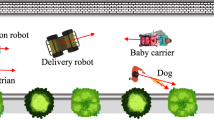Abstract
Future computing systems interact with a large number of users moving around buildings and streets. In this paper, we propose an example of such systems and how to evaluate ubicomp systems equipped with a large-scale physical environment that includes a large number of people inside. In our emergency guidance system, off-site guiding staff monitors a crowded large-scale public space to understand its situation, and instruct on-site guiding staff how to guide crowds effectively. Our system tracks and synthesizes the public space to enable the off-site staff to grasp it, and support communication between the on-site and the off-site staffs. Because it is not affordable to use the physical public space and a lot of human subjects to evaluate the system, we used our social interaction platform to simulate our guidance system. We could successfully construct simulations, in which the crowds are replaced with social agents in the virtual public space.
Preview
Unable to display preview. Download preview PDF.
Similar content being viewed by others
References
Abowd, G.D., Atkeson, C.G., Bobick, A.F., Essa, I.A., MacIntyre, B., Mynatt, E.D., Starner, T.E.: Living Laboratories: The Future Computing Environments Group at the Georgia Institute of Technology. In: ACM CHI2000 extended abstracts, pp. 215–216 (2000)
Abowd, G.D., Mynatt, E.D.: Charting Past, Present, and Future Research in Ubiquitous Computing. ACM TOCHI 7(1), 29–58 (2000)
Benford, S., Greenhalgh, C., Rodden, T., Pycock, J.: Collaborative Virtual Environments. CACM 44(7), 79–85 (2001)
Bohnenberger, T., Jameson, A., Kruger, A., Butz, A.: Location-Aware Shopping Assistance: Evaluation of a Decision-Theoretic Approach. In: Paternó, F. (ed.) Mobile HCI 2002. LNCS, vol. 2411, pp. 155–169. Springer, Heidelberg (2002)
Cassell, J., Sullivan, J., Prevost, S., Churchill, E.: Embodied Conversational Agents. MIT Press, Cambridge (2000)
Clark, H.H.: Using Language. Cambridge University Press, Cambridge (1996)
Crabtree, A., Benford, S., Rodden, T., Greenhalgh, C., Flintham, M., Anastasi, R., Drozd, A., Adams, M., Row-Farr, J., Tandavanitj, N., Steed, A.: Orchestrating a Mixed Reality Game ‘On the Ground’. In: ACM CHI 2004, pp. 391–398 (2004)
Drogoul, A., Vanbergue, D., Meurisse, T.: Multi-Agent Based Simulation: Where are the Agents? In: Sichman, J.S., Bousquet, F., Davidsson, P. (eds.) MABS 2002. LNCS (LNAI), vol. 2581, pp. 1–15. Springer, Heidelberg (2003)
Hall, E.T.: The Hidden Dimension. Doubleday (1966)
Helbing, D., Farkas, I.J., Vicsek, T.: Simulating Dynamical Features of Escape Panic. Nature 407(6803), 487–490 (2000)
Ishida, T.: Q: A Scenario Description Language for Interactive Agents. IEEE Computer 35(11), 54–59 (2002)
Ishida, T.: Society-Centered Design for Socially Embedded Multiagent Systems. In: Klusch, M., Ossowski, S., Kashyap, V., Unland, R. (eds.) CIA 2004. LNCS (LNAI), vol. 3191, pp. 16–29. Springer, Heidelberg (2004)
Kendon, A.: Spatial Organization in Social Encounters: the F-formation System. In: Kendon, A. (ed.) Conducting Interaction: Patterns of Behavior in Focused Encounters, pp. 209–237. Cambridge University Press, Cambridge (1990)
Linturi, R., Koivunen, M., Sulkanen, J.: Helsinki Arena 2000 - Augmenting a Real City to a Virtual One. In: Ishida, T., Isbister, K. (eds.) Digital Cities 1999. LNCS, vol. 1765, pp. 83–96. Springer, Heidelberg (2000)
Murakami, Y., Ishida, T., Kawasoe, T., Hishiyama, R.: Scenario Description for Multi-agent Simulation. In: AAMAS 2003, pp. 369–376 (2003)
Nagel, K., Kidd, C.D., O’Connell, T., Dey, A.K., Abowd, G.D.: The Family Intercom: Developing a Context-Aware Audio Communication System. In: Abowd, G.D., Brumitt, B., Shafer, S. (eds.) UbiComp 2001. LNCS, vol. 2201, pp. 176–183. Springer, Heidelberg (2001)
Nakanishi, H., Nakazawa, S., Ishida, T., Takanashi, K., Isbister, K.: Can Software Agents Influence Human Relations? In: Balance Theory in Agent-mediated Communities -. AAMAS 2003, pp. 717–724 (2003)
Nakanishi, H., Koizumi, S., Ishida, T., Ito, H.: Transcendent Communication: Location-Based Guidance for Large-Scale Public Spaces. In: ACM CHI 2004, pp. 655–662 (2004)
Nakanishi, H., Ishida, T.: FreeWalk/Q: Social Interaction Platform in Virtual Space. In: ACM VRST 2004, pp. 97–104 (2004)
Nakanishi, H., Shimizu, S., Isbister, K.: Sensitizing Social Agents for Virtual Training. Applied Artificial Intelligence 19 (2005) (to appear)
Patterson, M.L.: Nonverbal Behavior: a Functional Perspective. Springer, Heidelberg (1983)
Reeves, B., Nass, C.: The Media Equation: How People Treat Computers, Television, and New Media Like Real People and Places. Cambridge University Press, Cambridge (1996)
Reynolds, C.W.: Flocks, Herds, and Schools: A Distributed Behavioral Model. In: ACM SIGGRAPH 1987, pp. 25–34 (1987)
Scherer, K., London, H., Wolf, J.: The Voice of Confidence: Paralinguistic Cues and Audience Evaluation. Journal of Research in Personality 7, 31–44 (1973)
Sugiman, T., Misumi, J.: Development of a New Evacuation Method for Emergencies: Control of Collective Behavior by Emergent Small Groups. Journal of Applied Psychology 73(1), 3–10 (1988)
Tepper, D.T., Haase, R.F.: Verbal and Nonverbal Communication of Facilitative Conditions. In: Hill, C.E. (ed.) Helping Skills: The Empirical Foundation, pp. 211–223 (1978/2001)
Timney, B., London, H.: Body Language Concomitants of Persuasiveness and Persuasibility in Dyadic Interaction. International Journal of Group Tensions 3, 48–67 (1973)
Zimbardo, P.G., Leippe, M.R.: The Psychology of Attitude Change and Social Influence. McGraw-Hill, New York (1991)
Author information
Authors and Affiliations
Editor information
Editors and Affiliations
Rights and permissions
Copyright information
© 2005 Springer-Verlag Berlin Heidelberg
About this paper
Cite this paper
Nakanishi, H., Ishida, T. (2005). Designing Emergency Guidance in a Social Interaction Platform. In: Ishida, T., Gasser, L., Nakashima, H. (eds) Massively Multi-Agent Systems I. MMAS 2004. Lecture Notes in Computer Science(), vol 3446. Springer, Berlin, Heidelberg. https://doi.org/10.1007/11512073_21
Download citation
DOI: https://doi.org/10.1007/11512073_21
Publisher Name: Springer, Berlin, Heidelberg
Print ISBN: 978-3-540-26974-8
Online ISBN: 978-3-540-31889-7
eBook Packages: Computer ScienceComputer Science (R0)




